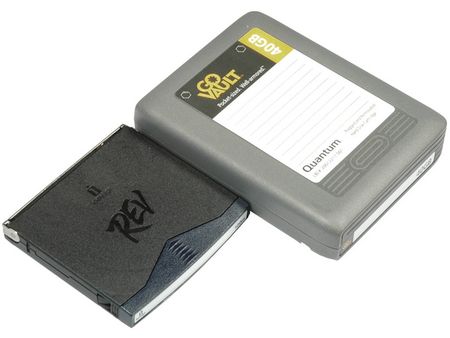Iomega And Quantum Tackle Backup
Backup: Disks And Tapes For The Enterprise
Traditional tape backup hasn’t died out and it probably will not become obsolete even in the long run, but its application and use have changed. While tape had been used to do straight file or system image backup using tape formats such as QIC or Travan, tape backup nowadays is based on formats such as Sony’s AIT format (Advanced Intelligent Tape for up to 400 GB), DLT (Digital Linear Tape for up to 800 GB) or LTO (Linear Tape Open for up to 800 GB), using rack mount autoloaders, which automatically change tapes, or even storage libraries to access hundreds of tapes and several drives.
However, tape-based backup is increasingly used for offline backup, which almost equals archiving. While LTO offers speeds of up to 120 MB/s, the other standards are clearly slower. Hence, regularly scheduled backups during a set time period of two or three terabytes of data wouldn’t be viable. This is why the industry differentiates between offline backup, near-line storage and online storage.
Online, Near-Line, Offline Storage
Hardcore tape backup is being used for offline storage where there is no frequent access to the stored data. Typically, you need the appropriate backup software to restore backup sets – this explains the term “offline” storage.
Near-line storage is increasingly being adopted with hard drives, as the cost per gigabyte is getting close to 15 cents per gigabyte of data. Huge RAID arrays using low-cost Serial ATA drives typically work very well for short-term backups and many data mirrors. These can be used to quickly restore older file revisions, or to create backups for offline solutions.
Online storage refers to high-availability, high-performance storage, which can be found in servers for databases, Web services and such. Clearly, this can only be realized using high-performance hardware.
Disk Backup for SMBs?
Get Tom's Hardware's best news and in-depth reviews, straight to your inbox.
However, hard disk backup is indeed an option for small businesses as well, since hard drive costs are extremely attractive from a cost-per-performance perspective. Purchasing several 500 GB or 750 GB hard drives doesn’t cost more than $100 each, and provides plenty of fast capacity for data backup.
However, storing important data on a hard drive is not a secure solution, as hard drives are rather sensitive and may just fail all of a sudden. Using hard drives as backup media hence requires even more planning, as you would have to take reliability issues into consideration. For example, will frequent removal and insertion of hard drives including many start/stop cycles decrease the life expectancy of hard drives? You should also back up data to more than one destination, and make sure that backup drives are physically independent from each other.
Iomega and Quantum Go for Disks
The Iomega REV120 is based on the well-known REV cartridges, which now store 120 GB instead of the initial 35 GB. Different from hard drives, the read/write heads are not part of the media, but are included with the drives.Quantum’s GoVault series is based on 2.5” Serial ATA hard drives, which are packaged into special cartridges in order to make the media more robust and easily exchangeable.
Current page: Backup: Disks And Tapes For The Enterprise
Prev Page Accomplishing Business Backup Next Page Iomega REV 120 GB